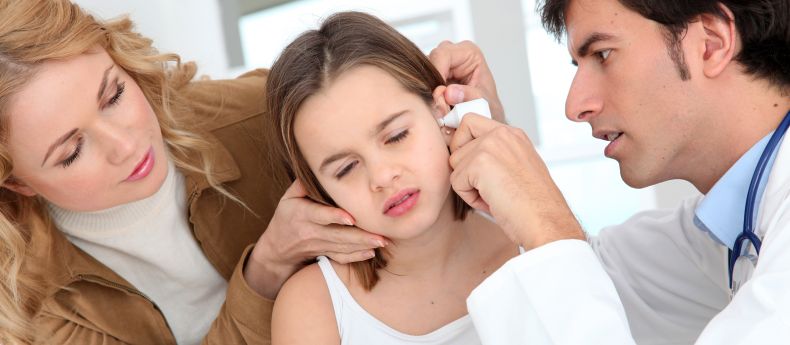
Little Ears, Big Problems
When kids get ear infections, it can have a direct effect on their hearing, so it is important to take these infections seriously. The internal structure of children’s little ears provides the perfect environment for many pathogens to grow. Here we’ll take a look at what Ear, Nose, and Throat (ENT) physicians recognize as the biggest problems affecting little ears, as well as how to treat them and prevent them.
Acute Inner Ear Infection
Why are children so susceptible to inner ear infections? The problem lies in their Eustachian tubes. The Eustachian tubes are directly connected to the nasopharyngeal region (right behind the back of the nose and throat). The Eustachian tubes’ function is to intermittently open to continuously provide fresh airflow to the middle ear, ensuring that the air pressure inside the middle ear is consistent with the air pressure outside the body. However, children’s Eustachian tubes not only have no way to effectively open and close, they are also short and wide, and their location in a child’s tiny head is right next to the child’s nose. So when a child gets a cold, it is very easy for bacteria to go from the nasal passage and the throat directly into the ear, leading to a middle ear infection. As kids get older, their Eustachian tubes gradually develop until around 10 years old when the child’s chances of getting a middle ear infection become extremely small.
Symptoms that suggest your child may have a middle ear infection:
- Fever
- Ear pain
- Thick nasal mucous
- Discharge leaking from the ear canal
Infants may have additional symptoms:
- Incessant crying along with a fever
- Grabbing their ears
- Shaking their head back and forth
- Rubbing their ears on nearby objects
- Unable to be soothed or difficulty feeding
- Abruptly waking up and screaming for long periods of time during the night
Going to the doctor
If acute middle ear infections are not treated promptly, they can lead to chronic inner ear inflammation, causing potential hearing problems later on and in some extreme cases, partial facial numbness from facial nerve damage, inner ear inflammation or brain abscess. So if you suspect your child has an ear infection, it is important to take him or her to see an ENT physician as soon as possible.
Normally, once a definitive diagnosis of a middle ear infection has been made, the doctor will administer oral antibiotics to treat the infection as well as other medication to help drain the ear if necessary. Because middle ear infections often coincide with infections of the nasal passage, the doctor will also examine the child’s nasal passage. If the nasal passage is also infected, the doctor will treat that infection at the same time as the ear infection, which may include nasal spray.
If your child requires medication for more than six weeks to treat the infection and the inflammation of the eardrum has still not gone away, the doctor will re-examine your child and may recommend making a tiny incision in the eardrum to allow fluid from the middle ear to drain completely. Once the incision has been made, infections typically take only one to two weeks to go away completely.
What parents can do
- Make sure your child takes the entire course of antibiotics prescribed in the correct dosage
- When your child’s ear hurts, use a warm hand towel to press gently on the outside of the ear for pain relief
- If there is pus coming out of the ear, you can gently wipe it away from the entrance to the ear canal with clean cotton swabs, avoiding putting the swabs into the ear as this can worsen the infection
- Follow all the doctor’s instructions and take your child to all follow up visits
- Have the child sit upright to nurse or take a bottle
- Keep the child’s nose wiped or use a respirator to help clear up mucous
Parents’ biggest concern: Will the incision in the eardrum affect my child’s hearing?
The vast majority of children who receive this incision do not experience hearing problems later on. The most important thing for parents concerned with their child’s hearing is to follow all the doctor’s instructions and complete the entire course of treatment recommended. Some parents see an improvement in how their child feels after 2-3 days and decide to stop the medication at that point. The unfortunate result is often that the infection has not entirely gone away and quickly comes back, which can lead to hearing damage.
Middle ear infections with discharge
This kind of ear infection is also called oozing or seeping middle ear infection. After their child is given medication for an acute middle ear infection and the symptoms have gone away, parents often relax, thinking that the infection is gone when in fact, even though the ear drum is no longer inflamed, the ear has not had enough time to naturally clean itself out and there is still infected fluid in the ear (in the tympanum). This is why it is critical that parents take their children for follow up visits after the child starts the medication. If your child does not finish the entire course of medication, and the child gets a cold soon after, infected fluid in the tympanum can persist, leading to an oozing ear infection.
Another significant factor in the development of oozing middle ear infections is swelling of the adenoids. If the child also has a stuffy nose, the doctor will check to see whether the child’s adenoids are swollen. The adenoids are the lymph nodes present in the nasopharyngeal region, and their swelling can affect a child’s breathing by blocking the airway.
Symptoms
- Impaired hearing is the main symptom
- Older children may complain of ringing in their ears (tinnitus)
Oozing middle ear infections usually do not cause a fever or obvious ear pain, so they can be difficult to notice. Therefore, parents must pay careful attention to symptoms that their child is having difficulty hearing such as:
- Child does not respond when called to
- When listening to music or speech, child tilts head toward the source of the sound
- Child still has difficulty speaking after 18 months old
Going to the doctor
Doctors can administer hearing tests (such as pure tone and acoustic immitance) to make a diagnosis. If the child does not have an infection or other disease, 75-90 % of the time this means the infection has already resolved itself and the remaining fluid will simply be absorbed.
If the infection is serious, the doctor may recommend making an incision in the eardrum in order to allow the fluid to drain. If this infection repeatedly recurs, the doctor may recommend putting in ear tubes, which are very small plastic tubes through the eardrum, to manage the fluid. The child will usually have the tubes for six months to one year. If the child’s adenoids are also swollen, the doctor may also remove the adenoids at that time.
What parents can do
- Try to minimize your child’s chances of getting a cold in order to avoid giving bacteria an opportunity to get into the middle ear and cause a recurrent infection
- Keep your child’s allergies under control, as they can exacerbate the infection. Try to keep your child away from smoky or dusty environments and avoid letting the child sleep with plush toys, which collect bacteria. Bring your child in for allergy testing if you suspect allergies are a problem.
- Try to breastfeed your child as late as possible. Studies show that children who are breastfed are less susceptible to ear infections, possibly because of the benefits conferred by the mother’s immune system.
Eczema of the external auditory canal
Just like other forms of eczema, eczema of the external ear canal is an allergic reaction. It is usually caused by moisture entering the ear, such as during feeding, bathing or sometimes when children sleep on their sides and moisture (perspiration) is pressed into the ear, irritating the auricle (folds of cartilage of the outer ear) and causing mild inflammation.
Symptoms
- Skin on outer ear is red or flaky
- Yellow fluid oozing from the ear canal
- The fluid may have an odor
Eczema of the outer ear canal can be very itchy for children, so children too little to talk may show other signs:
- Grabbing their ear
- Sticking their fingers in their ear
- Rubbing their head/ear on things
Going to the doctor
Eczema of the outer ear canal often occurs along with eczema of other parts of the body, sometimes making it necessary to use allergy medication to treat the whole body. Doctors can prescribe certain creams that can be used to alleviate the itching.
What parents can do
- Avoid getting liquid in the child’s ears. Be especially careful during bathing and breastfeeding
- Don’t let the child always sleep on the same side, which can trap perspiration in the ear
- Keep the child’s pillows and sheets clean and dry
- Keep the child’s nails trimmed
- An easy and highly effective remedy to alleviate the itching is to dip a cotton ball into some hydrogen peroxide and gently swab the outer ear. This not only stops the itching but also gets rid of any bacteria adding to the irritation
- Use hydrogen peroxide to clean off any oozing, as well. Be very gentle, and if you are concerned about hurting your baby’s skin, have a doctor do the cleaning
Outer ear inflammation
The majority of the time, this is caused by fluid such as water, milk or sweat getting into the ear. It can also happen when the child gets a cut on the outer ear and bacteria get into it.
Symptoms
- Mild contact with the ear causes a lot of pain
- The child cries when lying down on the affected ear or when changing clothes and the ear is brushed against
- Fluid from the ear has an unusual odor
- Pus on the ear
- Occasional, slight fever
Going to the doctor
The doctor will prescribe either oral antibiotics or an injection as well as medication for pain relief. If there is damage or pus inside the ear, the doctor will remove the pus in order to prevent the infection from worsening or causing hearing damage.
What parents can do
- Keep your child’s ears dry
- Be careful when removing your child’s earwax. In general, earwax does not need to be removed, so it is unnecessary to put anything in your child’s ears to clean them. Just keep the outer ear clean by gently wiping with cotton swabs
- Gently pressing a warm cloth against the outer ear can help with pain relief
Because ear infections can actually involve a lot of other factors of your child’s health, the doctor may ask some other questions, including:
- Does the child have a fever? What temperature?
- Have your child’s ears had discharge in the past?
- If your child has a cold, how long has it lasted?
- If your child has a cold, what medications have you used to treat it?
- Is your child’s nasal mucous normal or thick?
- Does your child have a cough or phlegm? What color is the phlegm?
- Does your child snore when sleeping? How loud is the snoring?
- Does your child have any known allergies or other sensitivities?
Here’s a quick checklist to make sure your child is showing signs of healthy hearing at any age.
Newborn to 3 months:
- Can be startled by noise
- Can be woken up by noise
- Baby stops crying or feeding when you talk to him or her
3 to 6 months:
- Baby turns its head to look at you when you start speaking
- Toys or objects that make noise attract the baby’s attention
- Baby smiles and responds when you talk to him or her
6 to 12 months:
- Baby turns its head to look for the sound of your voice
- If you call the baby from behind, he or she will turn around to find you
- The baby makes noises in response to you talking to him or her
12 months to 18 months:
- The baby can understand basic phrases like “no” “bye-bye” etc.
- When hearing the name of a familiar person or object, the baby will turn to face it
- The baby can at least say simple things like “mama” and “dada”
Copyright United Family Healthcare 2014 All right reserved - 京卫网审[2014]第1927号 - 京ICP备13017554号-4






